|
As I learned more about the "historic" flags of the American Revolution, I discovered that many of the flags, like many of the stories, are based more on traditions than actual facts. In short, they have become part of our mythology passed down generation to generation and many actually didn't exist except in fable. Like Paul Reveres' famous ride, or George Washington and the Cherry tree, they have become a rich and important part of our traditions that many people accept as fact, even if they, in fact, are not true. These short essay will attempt to discuss a few with an eye on history, rather than fantasy.
The Rattlesnake Naval Jacks
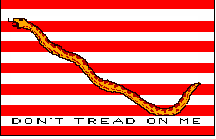 |
|
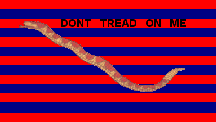 |
|
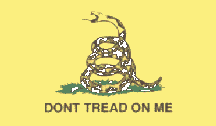 |
| First Continental Navy Jack |
|
South Carolina Navy Jack |
|
The Gadsden Flag |
Probably one of the most popular and recognizable flags to come out of the American Revolutionary War is the so-called First Continental Navy Jack. Not only is it readily available from most nearly every major flag manufacturer in the United States today, it is currently being used by the United States Navy as a jack in their War Against Terrorism. It is the perfect example of a flag that never actually existed becoming a reality by both popular and institutional acceptance. Although there is widespread belief that ships of the Continental Navy flew this jack, there is no firm bases of historical evidence to support it. In fact, it is unlikely this flag every existed or was used by the Continental Navy during the Revolution until after the tradition was established.
There is strong reason to believe that the actual Continental Navy Jack was simply a red and white striped flag with no other adornment (also known as the Colonial Merchant Ensign - see below). Today, this flag is usually identified with the "Sons of Liberty" who apparently used a similar red and white striped flag. However, by turn of the century the tradition of our navy using the symbol of the rattlesnake with the motto "DON'T TREAD ON ME" was firmly established in American myth. Most flag historians now believe it to be a 19th Century invention. |
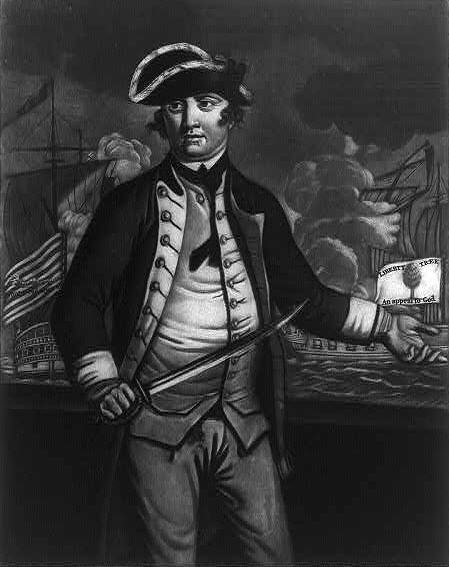
Portrait of Commodore Hopkins
by Thomas Hart |
It turns out that the only actual contemporary source of information about the Rattlesnake flag is a portrait of Commodore Hopkins by Thomas Hart published in London in 1776 (shown above). The Commodore is shown on the deck of a ship, sword-in-hand while what appears to be the "Don't Tread (up)on Me" flag. Unfortunately, the portrait has no relation to the actual appearance of Commodore Esek Hopkins or the ships and flags under his command. It was quite common for 18th and 19th century illustrators to create portraits of famous people that had no relation to the reality. Hart never saw Hopkins or knew what he really looked like and drew him and the flags from second-hand descriptions. Hopkins' real ensign was the Grand Union flag, which provided the stripes, and his standard was the Gadsden Flag which provided the rattlesnake and motto "DON'T TREAD ON ME," which the artist mistakenly combined to invent the famous striped rattlesnake flag. Curiously enough, it was the English press, not the Colonials, who established the existence of the fictitious flag.
Almost one hundred years later, in 1880, George Henry Preble published "History of the Flag of the United States" in which he identified the flag as the First Naval Jack and said "the striped jack may have been a flag of thirteen stripes, with a rattlesnake undulating upon it." On a color plate in this book it shows the "Don't Thread On Me" flag with red and white stripes, and a second version of the flag with red and blue stripes. Since his book was considered the definitive work on the history of the American Flag generations of subsequent writers have continued the legend.
Although the Blue and Red Striped Rattlesnake flag appears to be as fictitious as the First Navy Jack, it was associated with the South Carolina Navy in 1917 by a well-known article "Flags of the World" appearing in National Geographical Magazine, written by Byron McCandless and Gilbert Grosvenor. Although there was historically a South Carolina Navy, no one particular flag was ever identified with it, and no actual historical connection of the red and blue striped rattlesnake flag exists.
The Continental Colors/Grand Union Flag
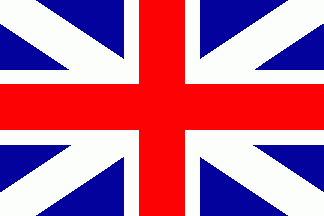 |
+ |
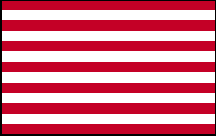 |
= |
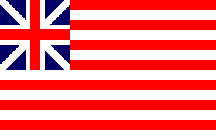 |
| The Union Flag/Jack |
|
Colonial Merchant Ensign |
|
The Grand Union Flag |
The legend that General Washington asked Rebecca Flower Young to make a flag for use by his troops when he first assumed command of the Continental Army is fairly well known to historians. The flag designed became known as the "Grand Union Flag." According to the legend, on January 1, 1776, this flag was first raised at Cambridge on Prospect Hill, where George Washington took command of the Continental Army. Although this flag was never officially sanctioned by the Continental Congress, we know it was in use from late 1775 until mid 1777.
Nobody denies the existence of this very famous flag or that it actually was the "de facto" first U.S. naval ensign after it was first raised aboard the Continental Navy's flagship "Alfred" by Commodore Esek Hopkins on December 3, 1775. The story of its first use on Prospect Hill is, however, is questioned.
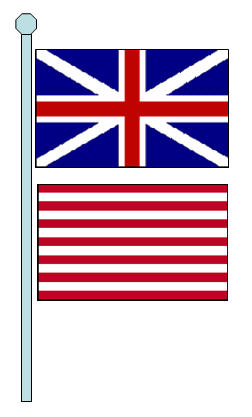
The Prospect Hill Flags
according to one witness |
|
Before we look at the events on Prospect Hill, it is important to remember that the British Union Flag/Jack was a "Royal" ensign and as such could only be used by official government organizations with Royal permission and/or by the Royal military. For anybody else to use it was against the law. On the very day that the colonists were forming their new Continental Army at Prospect Hill, a speech by the King arrived rejecting the colonist's "protestations of loyalty." In answer to the King's speech, the Colonists may have sent a strong signal if they raised the Union Jack, for they were breaking the law, and using it was a clear message of protest and defiance. It could only be used with Royal permission, and they didn't have it, or care.
The question arrises, was it the Union Flag as suggested above, was it the new Grand Union Flag as American tradition suggests, or was it a third possibility, two flags - the Union Jack over a Colonial Merchant Flag? Most flag historians dismiss the first possibility, that of a single Union Flag, on the bases that the political climate of the times would make it very unlikely. So was it two flags or one? |
According to Flag Historian Peter Ansoff there were only three eyewitness accounts that reported about what happened on Prospect Hill on January 1, 1776. George Washington himself said they hoisted the Union Flag, but was it the British Union flag or a version of the Grand Union flag. A second eye witness was a British merchant ship captain who also said they hoisted the Union Flag (but again which one), and lastly, a British lieutenant named William Carter who confirmed the Union Flag and added that a second flag flew below with thirteen red and white stripes (the Colonial Merchant's Ensign) as shown to the left. Ansoff thinks it was the two flags together.
Flag Historian Byron DeLear, however, disagrees. He points out that the third witness used the words "an union flag (above the continental with the thirteen stripes)." In the flag terminology of the day, he points out that the canton was often referred to as simply "above" and the field was referred to as "below." Thus, DeLear feels it was probable that William Carter (the third witness) was referring to a single flag of the "Grand Union" design.
Obviously, whichever flag flew on the hill, we can see the two original flag designs became blended into one, and the Grand Union Flag was the result. This flag was destined to become the Continental Navy's ensign and although the flag was never officially considered a national flag it was in use as one until mid-1777.
The Betsy Ross Flag
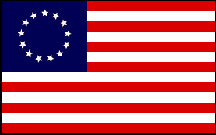
The Betsy Ross Flag
The "Betsy Ross" Flag is probably one of the most recognizable American flags today, but curiously enough it wasn't until the bi-centennial celebrations of 1989 that it became so overwhelmingly popular. It was then made the "official" first national flag, even though Betsy's participation in its design is still questionable.
In 1870, Betsy's grandson, William Canby, made a speech to the Historical Society of Pennsylvania describing how Betsy came to sew the first American Flag for George Washington and her uncle George Ross. According to his family traditions she then proceeded to make the flag we call the Betsy Ross Flag today. The story was then picked up and received national coverage thanks to an article in Harper's Weekly in 1873.
The problem is that, although Betsy did make flags for the State Navy Board as early as 1777 and continued until 1816, there is no official record of her making the "first" flag with the round pattern of stars. Although Betsy did, in fact, know how to make stars with one snip of the scissors, again there is no proof that she did so for the flag in question. At best, the whole Betsy Ross story is simply an undocumented, but interesting, American tradition.
|